Equipped to Respond
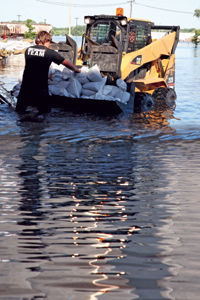
“There’s something about that moment in time when you’re standing with these people in their freshly destroyed community and you’re helping them in a way where they can see and feel it,” says Agoglia. “It has nothing to do with making money, but getting these people back on their feet again.”
Agoglia’s journey first began with his company Disaster Recovery Solutions in 2003, a government-hired contractor employed to clean up after hurricanes two to three months after they struck. While responding to these disaster sites, Agoglia realized his contracting abilities could have a bigger calling. He wondered: What was it like when the hurricane first hit? Do these communities need equipment to open up roads and clean up debris? How can I help?
In 2007, Agoglia took Disaster Recovery Solutions to Greensburg, Kan., where a devastating F-5 tornado had just hit. The company was able to remove debris and obstacles so ambulances and fire trucks could get through and access homes.
“We responded and sure enough, there was a need and we were there for weeks,” says Agoglia. “It really confirmed that after a storm strikes, these communities need specialized equipment — a lot more was needed than just opening up roads. There was no power for critical buildings and no specialized rescue boat for flood situations. There were no immediate water pumps onsite and no communication — it was chaotic.”
At the core of his relief efforts was a fleet of compact machinery. In the past, compact equipment such as skid steers and track loaders have found work on jobsites across America — building homes, sculpting landscapes, lending a hand in utility work. For Disaster Recovery Solutions, and eventually the First Response Team of America, these tough and reliable pieces of equipment would help them to clean up neighborhoods, restore order after a devastating storm and give a community hope in its darkest hour.
Soon the company was off to California in late 2007 to help out as wildfires and mudslides ripped through the state. Next, it was north to Oregon and Washington where citizens were suffering through floods and wind storms. After that, Agoglia was at a crossroads between his success as a contractor and responding to disasters.
“At the age of 30, I was a successful businessman and I guess it just wasn’t doing it for me. I wasn’t satisfied with just that in my life,” says Agoglia. “I was trying to figure out a way to not just do business, but also make a contribution to mankind. So I took my company and whatever equipment, manpower and cash it had, and for the next year and a half, responded to about 20 storms.”
From there, the First Response Team of America was born and Agoglia no longer did contractual work for profit. The team traveled all across the country responding to storms and lending assistance to communities in need. After the funds from Disaster Recovery Solutions ran out, Agoglia began to fund the First Response Team’s efforts with his personal finances. Recently, the organization became a non-profit, allowing people to contribute and promote its cause.
Bring in the Equipment
Responding to disasters takes more than guts and dedication — it requires an arsenal of hard-working machines designed to handle the tough tasks ahead. With more than $1 million in equipment, Agoglia and the First Response Team have an impressive fleet including: three Peterbilt trucks, a Godwin water pump, Terex light tower, 400-kW Caterpillar generator, several Caterpillar skid steers and even a hovercraft, to name a few.
Although all of these pieces play an important role in disaster response, Agoglia notes that it’s the compact equipment in his fleet that makes a lasting first impression. With uncertain situations, potential victims and challenging terrains before them, Agoglia and his team can move on to the disaster site carefully and armed for work.
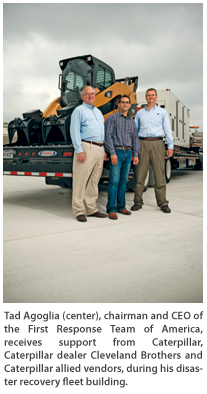
Agoglia’s skid steer lineup was first established with a Caterpillar 246 and two 252 B models. The First Response Team recently added three 299 machines to the fleet as well. With the skid steers’ versatility, compact size and use of attachments, Agoglia relies on these tool carriers to extract debris, as well as haul other gear and equipment that’s needed to help.
“Every single time we go into these situations, things are blown over and there’s excessive water,” he says. “We rely on the skid steers to create an opening so that emergency crews can access the community and people’s homes. You can’t show up with a bulldozer or other heavy piece of machinery, because you’re literally dealing with debris that may have potential victims in it. As a team, we arrive and carefully remove debris one piece at a time with our skid steers and attachments like grapple buckets.”
To further use the skid steers, Agoglia has designed the machines to not only haul debris and rubble, but also to escort other gear that’s needed. Agoglia had platforms welded to the team’s equipment, such as its light tower and rescue gear, so the pieces can easily hook up to the skid steers. With such a diverse fleet of equipment, all of the First Response Team’s members need to be able to operate the machines. Agoglia notes that because each disaster site poses unique challenges and dangers, all five men must step up and work with whatever equipment is needed at the time.
“Since we deal with a lot of emergency situations, everyone has to be trained on every piece of equipment,” explains Agoglia. “We’re not working in a normal jobsite; things are put through a blender. A lot of times we just have to help each other in the moment and teamwork is key. Whether it’s working with the search and rescue equipment, hovercraft or the pump, everyone needs to be versatile to really be a part of the team. The stark difference between what I used to do and what I do now is that it’s a matter of life or death — there’s not much room for failure.”
Although having quality equipment is vital during response operations, Agoglia says it’s also an important aspect in getting his foot in the door in ravaged communities. Backing up the team’s services with newer, reliable equipment allows local officials to see what the First Response Team has to offer.
“We have to have good equipment because having good equipment is like our ambassador,” explains Agoglia. “These community leaders may not know who I am, but they definitely recognize the Caterpillar brand. We don’t show up with an outdated truck and a beat up skid steer; we come with the latest and greatest equipment that’s just 20 ft away. All of this helps because I need to earn these people’s trust and they need to know that we’re here to help and can actually help.”
Reassuring a Community
With an equipment fleet ready to help and the passion to do the work, the First Response Team is on standby — waiting for the next disaster to unfold. Since Agoglia and his men travel frequently in order to respond to disasters, they don’t have a specific place to call home. Instead, the team sets up shop in various storm regions throughout the year so they can monitor the weather and react immediately.
“In the spring and summer, there are a lot of tornadoes and flood activity in the Great Plains region, so we try to stay in the middle of the country,” says Agoglia. “During hurricane season, we head south since most hurricanes happen in the south/southeastern states. In the fall, you’ll see a lot of mudslides and fires out West, so we migrate there.”
The First Response Team watches weather patterns and communicates with some of the world’s best meteorologists via satellite phone, cell phone or Internet. The weather professionals let Agoglia know when and where a potential storm will strike, allowing him and his team to respond immediately.
“We typically show up in the middle of the night, because most of these storms occur in the evening, and introduce ourselves to whoever is in charge — which is usually a mayor or fire chief,” says Agoglia. “We explain the resources we have and volunteer to help them. As a team, we come in very respectful of the community and its leaders, because we are there to serve under their guidance.”
Although the team initially operates under the local leadership, Agoglia explains that it is common for the community to ask him to lead after a 12- to 24-hour time period. Given his extensive experience in disaster response situations, Agoglia is more than capable of taking the reins to jumpstart the efforts. “It helps that we’re a little removed from the situation,” he adds, “because it’s not our community or our family members who may have been killed, it’s not our homes and lives that have been destroyed.”
After being accepted into the community, the team puts its equipment to work — opening up roads, lighting up buildings and lending assistance where needed. Agoglia and his team set up satellite communication, so people can talk to one another despite infrastructure being down. This allows the fire department and medical responders to connect, making it easier to work out a plan of attack. The team also provides search and rescue tools and scouts out the area on dirt bikes in search of victims. In flooding situations, the men pump water and perform water rescues with the hovercraft.
“Outside of those services, probably the most valuable one we bring to the table is leadership and experience in these types of situations,” says Agoglia. “We didn’t get this experience from being in simulated situations — we’ve been to these disasters and know what’s needed. The most exciting thing is — and probably what keeps me going — is the immediate effect that the help leaves on the community. These are towns that have been knocked off their feet and we go in and lend a hand with no strings attached.”
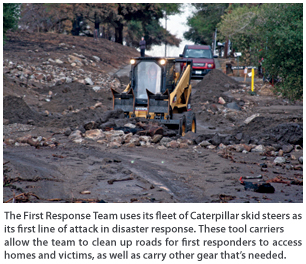
Continuing to Help
The past two years have been a whirlwind for Agoglia and his team, responding to 27 disasters all across the country. Since forming the First Response Team of America, Agoglia has been honored with the Jefferson Award for his work on Hurricane Ike, as well as named one of People magazine’s Heroes Among Us and CNN’s Top 10 Heroes of 2008.
As a new year begins, Agoglia looks toward the work ahead and has a few humble goals for his organization. Although 2009 brought about plenty of economic challenges throughout the United States, Agoglia hopes to pan out finances and donations in order to keep his team rolling (see sidebar on page 28). In the future, the team would like to add new technologies and equipment such as a mobile communications truck and fire engine. In the long term, Agoglia says he would love to develop a second team and increase the services his organization can provide. However, for now he feels fortunate enough with the group he has and the work that they do.
“When we come in, we create progress immediately and affect the psychology of the whole community — letting them know that they can fight back and rebuild,” says Agoglia. “Our assistance is helping these people to want to face tomorrow and we wouldn’t be able to do it without the necessary tools like compact equipment.”
Pam Stask is assistant editor of Compact Equipment, based in Peninsula, Ohio.
Donating for Disaster Response
As part of its fundraising for the upcoming year, the First Response Team of America has a challenge grant open with the Caterpillar Foundation to match funds through 2010. This is open to any dealer, business or individual donation received. Donations provide the resources needed for the First Response Team of America to quickly open up roads and stabilize communities, allowing safe access to disaster zones by first responder organizations.
For more information on how you can donate, visit www.firstresponseteam.org.


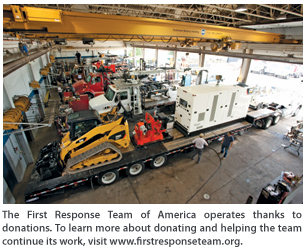

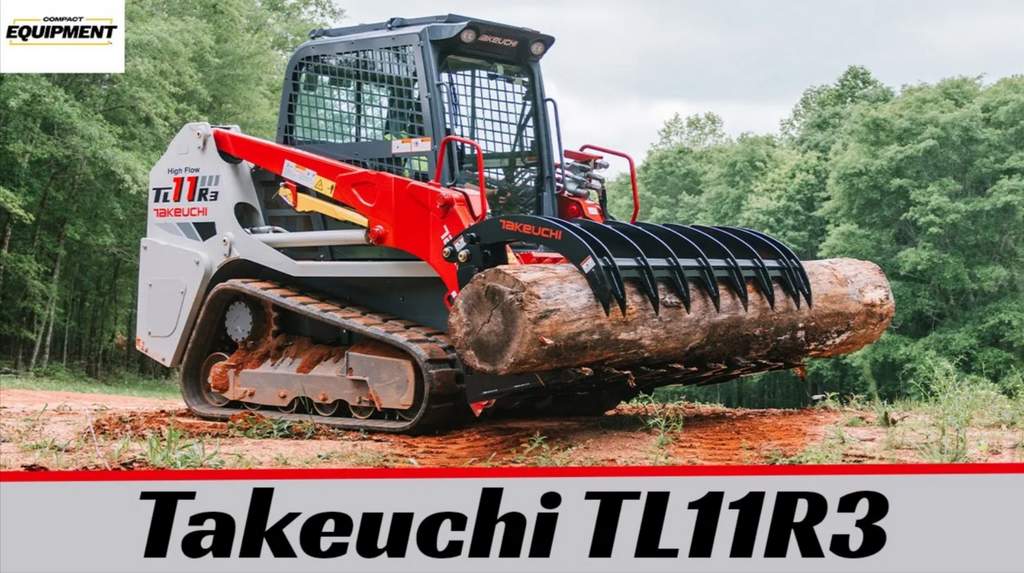

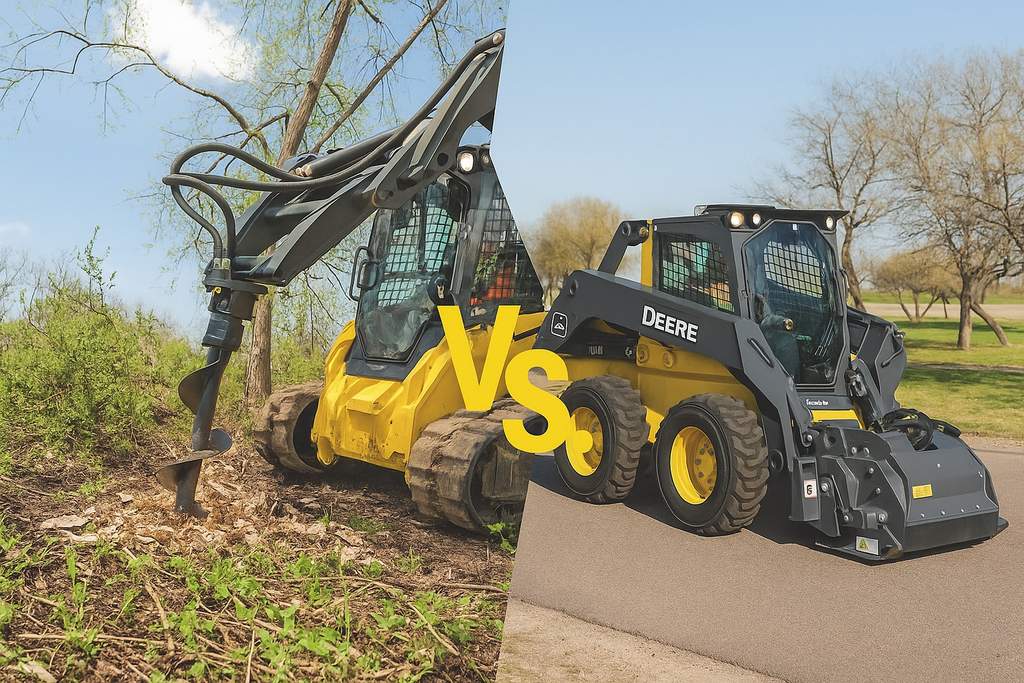
Comments are closed here.